Anet E10 3D Printer: Early Impressions and Experiences
I was wary at first, but I’ve come to be a huge fan of 3d printing. It goes hand in hand with CAD modeling, it can be used to test out designs or manufacture small widgets for the shop (or anything), and can be fun for making toys and other novelties. Up to now I’ve been printing on an Anet A8 printer; the infamous $165 eBay special that you build out of precut acrylic plates. To be honest it works well enough for what it is, minor adjustments are a near-constant necessity, and I’ve had my share of failed prints.
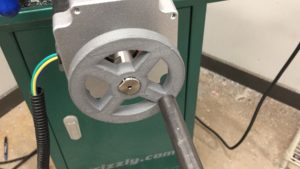
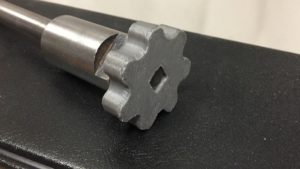
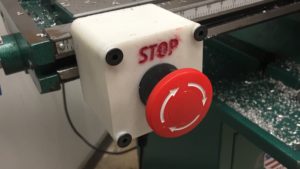
I was recently approached by a Chinese distributor of Anet printers, Gearbest.com, about the new offering from Anet, the E10. The E10 boasts a larger build area, an all-aluminum construction, a self contained controller box, and a slightly larger build area, amongst other upgrades. Gearbest offered to send me a machine in exchange for a review, so for transparency’s sake, you should know I did not pay for this machine, however, I was not given monetary compensation to review this machine. Once an agreement was met they sent me the machine so I could evaluate it.
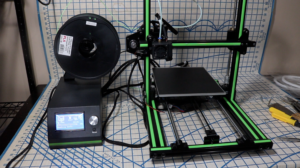
The machine shipped directly from china and came packed well and secure. In addition to the core components of the machine, you will also receive:
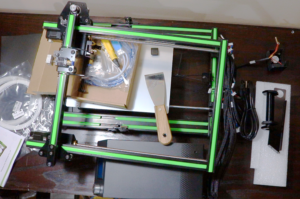
- 2 10m lengths of PLA (mine was white, I make no assumptions what color they will send out with others)
- a set of Allen wrenches
- a phillips/flat head screwdriver
- a USB microSD card adaptor
- a MicroSD Card (This has comprehensive build instructions as well as a lot of other data on it, so be aware of that)
- a USB cable
- a sheet of adhesive print bed material made by 3M (not sure what, specifically, this product is)
- a baggie full of spare T Nuts sized to fit the aluminum extrusions
- a spare extruder Nozzle
- a printed assembly pamphlet (very helpful but not as comprehensive as the instructions on the SD card)
Compared to the very-involved assembly of the A8, the E10 goes together very swiftly. Essentially, all you need to do is attach the upper frame to the lower frame, attach the hot end to the X Axis slider, and plug in all of the electrical components. As far as actual assembly goes, that’s it. A nimble-fingered person could likely do it in about 10 minutes, maybe even less. Setting up a camera between each process drug the whole operation out to closer to 20 minutes for me. Still, this is a massive difference from the 6-ish hours the A8 took me to assemble.
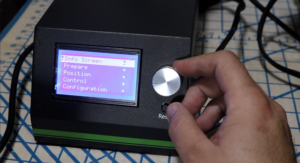
With the machine assembled, it was time to turn it on. The very first thing I noticed was how loud the controller box and all the fans are. We’re talking Gaming PC loud here. My initial optimistic thought was that the cooling of the controller box needed to be powerful because of the complexity of the controller. There are two interface inputs for the controller box; the first being a clickable wheel which you use for 100% of navigating through menus and selecting options, settings, etc. The wheel is novel, and the concept is solid, however, mechanically, the wheel can be difficult to use as it takes two or three “positions” of turning before it actually starts registering on screen. This can be very frustrating and the closest thing I can compare it to is like dealing with excessive backlash on the drive screw of a machine. The second interface on the controller box is a reset button, which is exactly that. Hit the button, and the machine off-and-on-again’s itself. This is a super convenient E-Stop for when your print starts failing, however, it is also frustratingly close to the dial wheel, causing accidental resets (oh boy ask me how I discovered this!) The controller box’s software is similar to the A8’s, it offers more control in some ways, and less control in others. Things I like about the A8’s controller screen are a readout of the Z height, as far as where the machine thinks it is, which is handy in dialing things in and solving issues, as well as an easy way to switch between finely stepping the motors or rapidly traversing them. The E10’s controller doesn’t feature these, it offers different distance/speeds to move the motors, but only certain speeds for certain axes, which is odd and makes things slow.
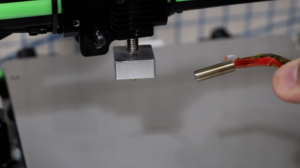
Running a basic preheat procedure for PLA led me to discover the first issue; the nozzle just wouldn’t come up to temp. The table, on the other hand, came up to temp very quickly, much faster than the table of the A8. In diagnosing the nozzle I quickly discovered that the heating element’s thermocouple is too short to properly seat inside the heating block of the nozzle, and causes it to misread a much lower temperature. It was very frustrating to get the thermocouple into position; the wire bundle that holds it has to be pinched through a tight slot in the cover box for the tight end; this puts strain on its wire and can easily undo any careful adjustments you’ve made to get the thermocouple to its home. Trying to get the thermocouple into where it belongs to the point it would give me a (relatively) accurate temperature reading added another hour to the setup time. I’m actually a little worried that I’m still not getting an accurate temperature reading, and that my nozzle is far too hot.
After that amount of adjusting and fiddling just to get the machine to preheat, I immediately came upon the next problem; the filament wouldn’t feed. Once again chasing the problem, adjusting, fiddling, etc., added about an hour to discover that the nozzle on the machine was clogged as it came to me. Thankfully the machine comes with another nozzle and I was able to finally change it out to one that would allow me to finally print.

The first print was of the ubiquitous “Benchy.” Benchy is a little cartoonish boat with a number of 3d features on it, and the 3D printing community has adopted it as an unofficial first test print for any new 3d printer, a “benchmark.” Benchy came out just fine using PLA I sourced from a local computer store. The windows and some of the edges had little “hairs” floating in the gaps and off the sides; I presume I either had my nozzle set too hot or the nozzle is hotter than the machine thinks it is. However, I consider it to be a very successful print and a great example of what this machine is capable of!
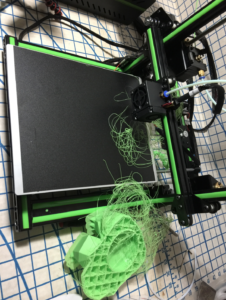
I next tried to print a large “Bulbasaur” Vase, a file I found on Thingiverse. The print started off just fine and I actually let it print overnight– the first and only time I ever did that with this printer. We woke up the next morning to an absolute mess and an obviously failed print. After reviewing the time lapse footage, somewhere during the print, the entire Z axis started moving down instead of up. Spoiler alert- this happens a lot more. I double checked all my settings and adjustments in both the machine and in Cura, my print slicing program. I found no direct culprit, but decided to keep trying prints.
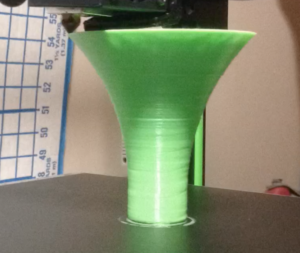
I modeled up a trumpet-style cone in Fusion 360 based off a fun idea I had. Towards the end of the print, the same issue occurred and I stopped the print once I realized the Z Axis had reversed itself and was going back down. Once again frustrating and confusing. The print itself also seemed to have more layer lines than the Benchy model, reminding me of some of the lower quality prints I’d come up with on the A8 whenever it wasn’t well adjusted.
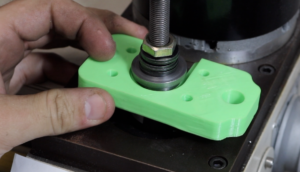
Without being able to diagnose an actual culprit for why the Z Axis just decided to switch directions at a random level, I pushed on and started printing pieces out of a future project, which I happened to have modeled up in Fusion 360. These are intended to be CNC Machined out of cold rolled steel, but I figured it’d be fun to print them out before hand. I started by printing the base piece of the part which is a relatively simple, boxy geometry. Amazingly, it printed without issue. There were a couple of odd spots where the flow seemed to change, like little swollen patches around the side, but other than that the part came out looking fine and being accurate to its necessary dimensions.

With this success I went to print the next pieces of this project, two uprights, of similar size and geometric style. The printer just wouldn’t print them. Several non-starts or failures at the first level. I tried at least half a dozen times to print these, each time of course making sure my bed was properly level and my nozzle height was properly set. I tried different g code files, different settings in Cura, different orientations, it’s as if the printer would just throw a tantrum trying to print this specific shape. I’m honestly still entirely befuddled. I was even able to get successful prints of other items in between these prints, so it’s not like there was some wild maladjustment on the machine itself. Unfortunately, frustrating.
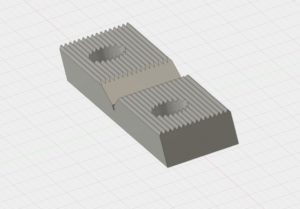
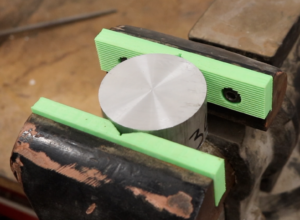
Going with a different direction, I wanted to try an experiment I’ve thought of in the past of 3d printing a set of soft jaws for a bench vise– I still think this would be a viable means for making soft jaws and even specifically shaped jaws, say for the CNC Mill. I took dimensions of the existing jaws and plugged those into a sketch in Fusion 360 and started designing the parts. I added in a V Groove for holding round objects to the center of the Jaws and also modeled in some triangular “teeth” as an interesting design element. These features were mostly for fun and as an example of concept, instead of being based on any actual design. Once again in a surprising manner, the part made it all the way through the printing process, and actually mounted to the vise! If one were doing this sort of operation, I would recommend 100% infill, as it is I used 15% and expect the jaws to be appropriately weak. They did, amazingly, hold into a 2.5″ piece of aluminum round rather well, stiff enough to do some light filing into the top, so even though they were printed as an example, they are actually useful. Hitting the aluminum with a hammer, however, was (obviously) enough to unseat the part with minor damage to the contact points in the vise jaws. These jaws printed, but didn’t print perfectly; there were hairline gaps all amongst the sides and a few layer variations, small but noticeable defects.
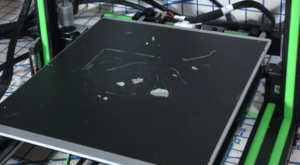
After about a dozen prints, the 3M Print bed covering shows a good amount of wear. I give it credit for how well PLA sticks to it, I’ve had zero issues with print bed adhesion, which is actually nice because that’s the biggest issue I run into with the A8. The material sticks so well, however, that it tends to leave little bits of itself to the bottom of prints. This can be a little frustrating if you aren’t wanting a little black spot on the bottom of whatever you’re printing, plus it creates a damaged spot on the bed. I’m not sure how easy it’s going to be to change out, it’s stuck down fairly well and it seems like the plate underneath will need a thorough cleaning to get all of the residue off.
So, all in all, my overall opinion of this machine is, unfortunately, not great. For it’s price point (around $300US) it bears a very competitive set of features; the aluminum frame, the controller box, and the large print area. I had very high hopes for this machine to at least be decent, I was excited to have it to expand my 3d printing capabilities. I really, really wanted to be able to give you a review that said this machine was the next step up from an A8 and a great upgrade in machine for only a small upgrade in price. Sadly, I have not had a very reliable time with it. I’ve had more fails and mis-starts than completed prints with this machine, by a large order. There are some Quality Control issues that are very small things but make a huge difference, like the thermocouple and extruder nozzles, two tiny details that required quite a bit of buggering before the machine was even ready to make its first print. I’m honestly thinking that something in the controller software or the firmware is flawed, causing the huge issue with the Z axis wanting to reverse randomly mid print. As stated before I’ve explored every possible setting, option, and adjustment in preventing it, to no avail. As it is, I’ve had significantly more success with the cheap little A8 printer over the last several months (I bought the A8, by the way, knowing absolutely zilch about 3d printing at the time so I’d dare say it scores double points for being remarkably idiot-friendly) than I have in the past few weeks going round and round with this E10. I sincerely hope whatever issues with this machine can be resolved, and if I figure out the source of mine, I will happily give an update.
If you are interested in purchasing this machine for yourself, here is a referrer link to it http://www.gearbest.com/3d-printers-3d-printer-kits/pp_664901.html?lkid=11126217
I do get a small percentage of the sale if you purchase it through that link. The code ANET10 will get you a price of 279.99 with a spool of filament.

